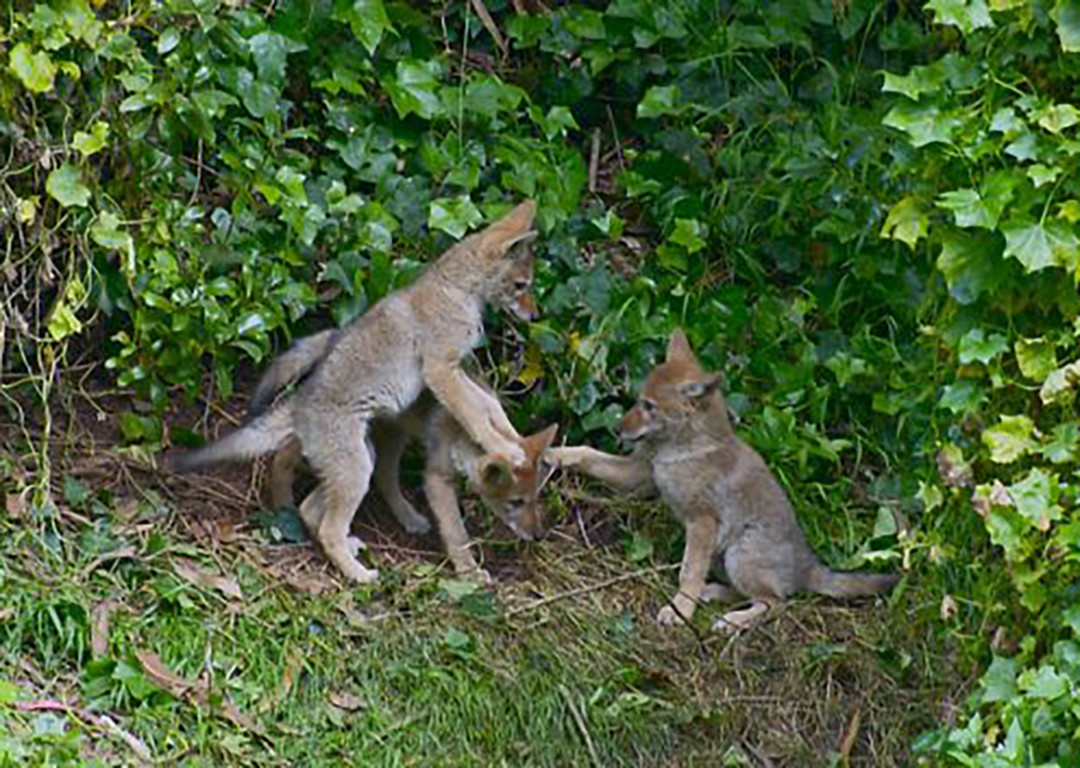Photo: Its a little after sunrise, three coyote pups on their forest knoll in Golden Gate Park. Mother coyote watches from above (outside of frame). Taken for Natures Lantern founded by David Cruz. By David Cruz, Special To The Chronicle
By Peter Fimrite
The revelation, along with photographic proof, that at least three coyote puppies were recently born in Golden Gate Park raises some interesting questions about the future of the park – namely, how much time before roving packs of yipping wild predators drive humans and their decidedly un-wily pets out?
That, at least, is what the alarmists are asking, and the answer, according to the experts, is “never.” The presence of coyotes in the city is good for the ecosystem, city officials and wildlife experts said, even if a few feral cats go missing.
“It is important that people recognize that coyotes are part of our ecosystem and that they have intrinsic value and ecological value,” said Camilla Fox, the executive director of Project Coyote, a Larkspur nonprofit that consults with cities, ranchers and other groups on ways to live with coyotes without resorting to bullets, traps and poison.
Coyotes, she said, “keep the rodent population and other mesocarnivores – like foxes, skunks and raccoons – in check, which helps songbird and ground-nesting bird populations.”
The cute, furry pups, born this spring, bring the number of coyotes living in San Francisco to 13, according to the best estimates of city Animal Care and Control officials. It is part of a Bay Area-wide coyote population explosion and a remarkable migration of the wily canines from the suburbs into the city over the past decade.
Sightings of the clever carnivores began in 2004 in the Presidio, creating excitement and a good deal of puzzlement over how the animals got there. Answers came shortly after the first encounter when Golden Gate Bridge officials looked at a videotape that showed a coyote trotting across the bridge in the middle of the night.
Once plentiful in S.F.
Coyotes have since been reported in Golden Gate Park, Glen Park and Bernal Heights. Genetic testing of two coyotes in Golden Gate Park shot by federal authorities in 2007 after they attacked dogs confirmed that the animals came from the north.
There was once a native population of coyotes. They were plentiful in San Francisco long before Europeans arrived, according to historical and fossil records, but the local population was killed off around the time of the Gold Rush. An article in the Daily Alta California on Sept. 15, 1860, told about a coyote that snuck into the city and ran off with a hen.
“Time was, and not long ago either, when such varmints loped fearlessly among the chaparral where now stand blocks of buildings,” the story said.
Coyotes are not normally aggressive against humans or dogs, Fox said, but they will protect their dens from intruders during the pup-rearing season, which lasts from April through August.
Sporadic instances of aggressive behavior, including a few reported cases of coyotes charging pedestrians and pets, have terrified habitues of Golden Gate Park and prompted calls for the city to get rid of the coyotes.
“A lot of people freaked out about it, but in hindsight we realized they were probably protecting a den,” said Rebecca Katz, the director of San Francisco Animal Care and Control. “What we are trying to do now is get more people educated about coexistence. It’s not an option for us to remove them. We’re not willing to kill off the coyotes. We think we should learn to coexist.”
Dogs can be aggressors
Sometimes, Katz said, dogs are actually the aggressors. An off-leash rottweiler was recently videotaped confronting two coyotes, which then harried the dog in an apparent attempt to prevent it from entering a den area, but no actual contact was made.
To guard against incidents like that, city officials have cordoned off trails, barricaded a restroom and put up “Be Coyote Aware” signs along John F. Kennedy Drive in the Chain of Lakes area, where the coyote family is known to have set up housekeeping.
Animal control officers are urging people to keep dogs on leash in the area and discouraging people from feeding coyotes. Several folks who feed feral cats in the park have been told not to leave the food out, lest they draw the coyotes to the area. A recent study in the Malibu area found that 13.6 percent of coyote scat contained cat remains.
Local residents and businesses have been warned not to leave garbage out.
“One of the ways we keep the population from being overly large is to not provide them with unnatural resources, like food from feeding or from garbage cans,” Katz said. “That way the population should stay relatively stable.”
Shorter life expectancy
Those worried about coyotes taking over the park should calm down, Fox said. Coyotes in urban areas often get hit by cars or suffer in other ways. Coyote pups generally have a 50 to 70 percent mortality rate in urban areas, she said.
“Coyotes are self-regulating in that they will not exceed the biological carrying capacity of the area,” Fox said. “Life expectancy is shorter in urban areas.”
Download the article here.

